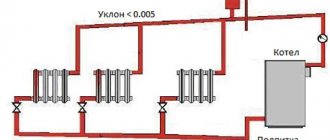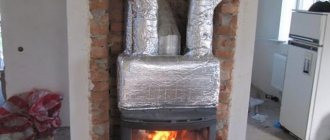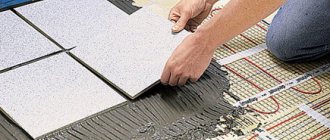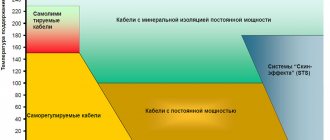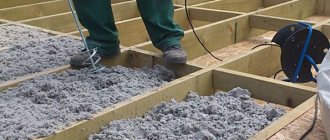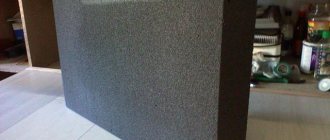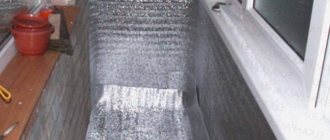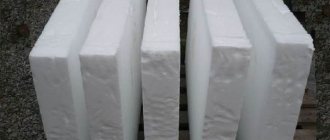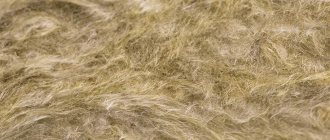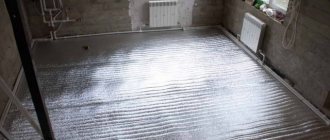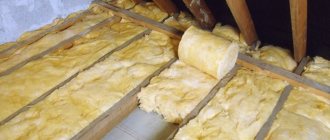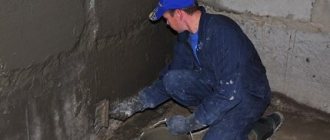Requirements when choosing glue
You can glue polystyrene foam to walls, ceilings or other surfaces for insulation with your own hands - the process is simple. A high-quality adhesive composition must meet a number of requirements. First of all, it should not contain harmful components that destroy the foam:
- ketone-based solvents, including acetone;
- nitrogen compounds – nitromethane, nitrobenzene and others;
- chlorine derivatives;
- petrochemical products – gasoline, white spirit, kerosene;
- alcohols and ethers;
- other flammable substances that disrupt the structure of the material.
Even a small percentage of such additives will, over time, negatively affect the quality of the lining of a house or other premises. Also, when selecting glue, it is taken into account whether it will be used for exterior work or inside the building. Houses covered with polystyrene on the outside are exposed to low temperatures, and the product must be frost-resistant.
The instructions for the adhesive mixture always indicate what types of substrates it is suitable for. It is necessary to clarify whether the product is suitable for application to concrete, wood, and metal surfaces. If necessary, the glue must adhere securely to putty and other heat-insulating materials (isolon, EPS). To attach sheets of foam plastic to each other, you can use dry or “wet” glue.
How to properly prepare walls before gluing foam plastic
Let's pay attention to the walls of your house, which you have decided to insulate. Of course, since the foam is smooth and dense, in order for it to adhere well to the walls, they must be properly prepared.
First of all, it is advisable to plaster the walls. If your house is made of gas silicate blocks and the master did the laying smoothly, then it is not necessary to plaster the walls. However, in this case, it is necessary to cover all the joints of the blocks.
If the walls are not level, they need to be leveled. Walls can be leveled either with or without beacons.
The beacons are placed on the solution and leveled using a bubble level. This way you will create a flat surface with the correct vertical level.
The last step before you glue the foam to the walls is the primer. Be sure to use a primer! You should not skimp on primer, as it creates good adhesion, which helps the foam to firmly adhere to the walls and not fall off.
Types and manufacturers of adhesives
The construction market is filled with different compositions for gluing foam plastic. Typically for this purpose it is recommended to use:
- foam, foam glue;
- liquid Nails;
- powder masses;
- adhesives-sealants, etc.
Dry mixes
Such materials are sold in large bags (up to 30 kg) and diluted with water. The powder looks like putty or plaster, but contains stronger binding components. This method of wall insulation will be the most budget-friendly. Typically, mixtures are prepared based on cement, gypsum and a number of polymer additives. The reliability and durability of adhesives leaves no doubt. Quality brands are considered:
- Ceresit ST-83;
- Knauf Perlfix;
- "Avangard-K";
- "Primus";
- "Volma";
- Armierungs-Gewebekleber.
Most mixtures are suitable for gluing foam plastic outside and inside the house - to concrete, wood and other materials. From them you need to prepare an adhesive solution, adding the amount of water specified in the instructions. Consumption per 1 sq. m of surface – approximately 1.5-2 kg of finished mass. Many compounds can be used to additionally seal the seams between the slabs, and they are also suitable for puttying walls.
To improve adhesion to the base, before starting work, the walls are cleaned, dried, and primed. The solution must be mixed thoroughly; there should be no lumps in it. The glue is applied with a spatula in strips or in a continuous layer - along the edges, in the center.
Polyurethane adhesive foam
What is the best way to stick foam on the wall? Polyurethane composition is ideal for this purpose. There are even special foams on sale labeled “for polystyrene foam.” They can be applied to vertical and horizontal substrates and used for interior and exterior work. Well-known brands are Tytan Styro 753, Penosil, Ceresit ST-84 Express.
Polyurethane foam adhesive easily connects plastic and all its derivatives (including polystyrene foam) to any surface. It allows you to attach blocks to OSB boards, metal, concrete, plaster, wood, aerated concrete, and foam blocks. The advantages are obvious:
- high speed of installation of slabs;
- moisture resistance, frost resistance;
- ease of use;
- low consumption.
Bonding of materials with polystyrene foam will be reliable, the adhesion rate is maximum. There is no need to dilute the glue; it is sold in ready-made cans. Consumption of one package is 10-15 sq. m slabs. The polyurethane in the composition allows you to fix the materials within 20-30 minutes, and you need to hold the foam with your hands for no more than 20 seconds.
PVA
Is it allowed to glue polystyrene foam using PVA? The choice is popular due to the low cost of the product. Unfortunately, the degree of fixation of this glue is not sufficient to create durable insulation. But PVA can play a role: it will serve as a filler for voids in the wall, and the quality of fastening will be improved by dowels. The double technique will allow you to save money and get the job done without delay.
Some people practice gluing foam to metal using PVA. This can be done, but the consumption is very high, and burlap is used as a layer.
Polyurethane foam
Is it possible to glue polystyrene foam onto polyurethane foam? Professionals and beginners alike respect it due to its efficiency, excellent adhesion to the surface and reliability of the adhesive seam. It is convenient to work with foam; it is easily sprayed from a container. And yet, the purpose of this tool is somewhat different. It is used to seal grooves, cracks, and strengthen concrete structures. Of course, it is possible to attach polystyrene boards to iron, concrete, brick with foam, but there are a number of disadvantages:
- all operations will have to be performed very quickly, the material will soon harden;
- after hardening, it expands greatly in volume and can deform thin foam plastic and cause curvature of the homemade structure;
- due to uneven expansion, voids can form in some areas, which deteriorates the quality of thermal insulation;
- The material consumption per square meter is high, the cost of repairs will be far from budget.
Many polyurethane foams, moreover, contain components that corrode foam and are not suitable for it. Therefore, the correct procedure is:
- immediately determine whether the product is suitable for polystyrene foam;
- glue the blocks onto the walls using a different glue;
- Fill the joints between foam plastic boards with polyurethane foam.
You can reduce the consumption of foam material by using a glue gun; saving on its purchase is impractical.
Liquid Nails
What glue do professionals use most often? Craftsmen often prefer liquid nails “Moment Installation”, Dragon and a number of others. All work involving this product will be completed quickly and efficiently, because the adhesion to the surface, hardening speed and service life are in an optimal ratio. In terms of bond strength, liquid nails are second only to polyurethane foam adhesives. Therefore, for complex substrates (for example, metal sheets), experts advise using the two indicated products together.
To optimize adhesion, the surface should be cleaned, degreased and, if necessary, primed. This way you can glue polystyrene foam even to the ceiling. Due to their high cost, liquid nails are usually used in small areas.
How to choose adhesive for polystyrene foam
Professional builders recommend choosing a certified universal adhesive with confirmation of its safety and environmental friendliness. The mixture for polystyrene foam is produced for use in summer and winter. When choosing, pay attention to the operating temperature range. To insulate metal surfaces, experts recommend using polystyrene foam adhesive. It will provide better adhesion and dry quickly.
Professional builders recommend using dry polymer-cement mixtures for the manufacture of thermal insulation structures of the “wet facade” type. It is necessary to apply the prepared solution in a continuous layer over the entire surface of the slab; this method ensures 100% reliable fixation and eliminates the movement of air between the wall and the insulation.
Photo 5. Adhesive solution for polystyrene foam
Attaching foam to different surfaces
In order to properly glue polystyrene foam, it is important to know the specifics and properties of the base material. There are a number of features that must be taken into account during installation.
Concrete
Craftsmen often try to save money when insulating concrete walls with polystyrene foam without making lathing. Indeed, it is possible to glue the material directly to the wall. For this purpose you will need the following tools and consumables:
- primer;
- putty knife;
- cement;
- sand;
- glue;
- drill.
To improve the quality of the clutch, preparations are made. The surface is cleaned of dirt, dust and stains. Unstable areas will have to be puttyed again after removing the old coating. At the end of the preparatory work, the wall is primed. Typically, dry adhesive mixtures are purchased to connect foam and concrete. They are diluted with water according to the instructions, the proportions are indicated in it. Mix using a drill with an attachment; a construction mixer is also suitable. Next, wait the time indicated on the package to infuse the solution.
How to glue foam to concrete? The tips are:
- in the presence of small defects or minor irregularities, the glue is applied in continuous strips, 2 cm apart from the edges;
- if the wall unevenness is more than 2 cm, lubricate the foam in strips with gaps (this will remove excess air);
- Be sure to apply the product to the middle of each slab;
- Press the material against the wall, and immediately remove excess glue with a rag.
Additionally, it is recommended to fasten with dowels - in the center, in the corners. It is also possible to attach the material with sealant or liquid nails and dowels; the seam will also be reliable. Instead of these materials, special polyurethane glue, which is applied using a gun, is suitable.
Metal
How to properly attach heat-insulating material to an iron surface? Most of them have the same rules. Polystyrene foam, extruded polystyrene foam, and penoplex are attached to metal using burlap. After joining with the latter there will be no problems with repairs; you can use almost any glue. If you need to seal small areas inside the house, you can even use double-sided tape. Also an important nuance is the obligatory cleaning of the wall from rust - if this is not done, the adhesion of the glue will decrease.
Expanded polystyrene is attached to the metal base by the following means:
- aerosol adhesives;
- sealants with silicone;
- polyurethane and mounting foam;
- dry polymer mixtures.
An excellent option would be to work with one-component polyurethane glue, which is sold in cylinders. It can also be produced in the form of adhesive foam. If foam is attached to a sloping or uneven metal wall, this adhesive is the best choice for a craftsman. It is also used without burlap in cases where it is impossible to attach the latter. There must be at least 5 dots of any glue on the foam sheet. After dilution, dry mixtures are applied in strips, as described above for concrete surfaces.
Tree
In general, the procedure for gluing foam plastic to wooden bases is similar. We are talking about fastening to plywood, OSB boards, lining, boards. Features of the work are as follows:
- Before pasting the walls, it is important to completely clean them of debris and dust, if necessary, wash and dry them;
- priming is mandatory, for old wood - 2-3 times;
- if the foam plastic is attached under the windows, a reinforcing mesh is first attached to the wood (using a construction stapler);
- voids in the walls and cracks are filled with polyurethane foam, after a day its excess is cut off;
- protruding areas, knots are cramped;
- The remnants of old varnish are completely removed from the wood, they destroy the foam.
The adhesive mixture is distributed evenly over the foam sheet, in strips, moving away from the edges. Next, stripes are drawn along diagonals. You can use any glue that is suitable for polystyrene foam and has additives against fungus and mold.
Features of installation of polystyrene foam
Extruded EPS is a high-density foam material. It is this indicator that distinguishes it from ordinary polystyrene - polystyrene foam. The density increases during the production process when passing through the extruder, this seriously increases the thermal insulation characteristics of the material. The final slabs consist of polymer and small air bubbles.
Due to the smoothness of EPS boards, they have very weak adhesion to the adhesive composition. This is the main problem when gluing. It can be solved by selecting special adhesives that themselves have high adhesion to any surface. Also, some products can partially dissolve the foam top of the slabs by being absorbed into them.
The specifics of installing polystyrene foam boards are as follows:
- if the material is purchased as floor insulation, it is laid on an expanded clay pad or on a pad made of other low-density material and filled with concrete,
- to insulate the foundation, the slab must be glued to the concrete of the base and secured with mounting fasteners,
- material is laid on the roof, then a layer of bitumen is placed or PPS is laid between the ribs of the rafters inside the roof layers,
- When insulating the ceiling in an apartment on the top floor, polystyrene foam is laid on the attic side with glue, then concreted or covered with crumbs, gravel, expanded clay.
TECHNONICOL FOAM ADHESIVE
One-component polyurethane adhesive for fastening expanded polystyrene and extruded polystyrene (XPS) boards. Consists of isocyanate oligomers, displacing gas - propane / isobutane.
Advantages
- convenient and easy to use;
- reduces work completion time;
- high adhesion to concrete, cement plasters and other mineral bases, as well as to wood, particle boards, OSB boards, mosaic cladding, bituminous materials, etc.;
- good resistance to humidity, mold, aging;
- low thermal conductivity;
- minimal secondary expansion.
Application
TECHNONICOL FOAM GLUE is intended for fastening slabs of expanded polystyrene and extruded polystyrene foam (EPS) to the base when insulating the external and internal walls of a building, roofs, basements, foundations, floors in both new and reconstructed buildings. Specifications
| Indicators | Unit measurements | TECHNONICOL FOAM ADHESIVE |
| Strength of adhesion (adhesion) to a concrete surface, not less | MPa | 0,4 |
| Adhesion strength (adhesion) with polystyrene foam, not less | MPa | 0,09 |
| Thermal conductivity | W/mK | 0,035 |
| Degree of evacuation of contents from packaging, not less | % | 85 |
| Polymerization start time, no more | min | 15 |
| Curing time at 20°C and relative humidity more than 50%, no more | h | 2 |
| Complete curing time, no more | h | 24 |
| Density after curing | g/cm3 | 25 |
Fastening polystyrene foam
Used at temperatures from 0°C to +35°C.
- Place the TECHNONICOL GLUE-FOAM cylinder for polystyrene foam with the valve side up on a flat surface, remove the protective cap from the valve and carefully align the cylinder valve with the landing bridge of the mounting gun. After installing the cylinder on the gun, shake the cylinder vigorously 20 times.
- TECHNONICOL FOAM GLUE for expanded polystyrene is applied with a mounting gun in the balloon upward position, maintaining the distance between the gun and the plate for proper application of the glue.
- TECHNONICOL FOAM GLUE for polystyrene foam should be applied around the perimeter with an indentation of approximately 2 cm from the edge of the slab in strips about 3 cm wide and one strip through the center of the slab at an equal distance from its long sides. After applying TECHNONICOL FOAM ADHESIVE for polystyrene foam to the slab, you must wait at least 5 minutes for the foam to fully expand, and then fix the insulation slab to a vertical surface.
- Attach the slab with TECHNONICOL FOAM ADHESIVE for polystyrene foam to the wall and press lightly. Fix the slab until the glue sets. Insulation boards should be fastened close to one another with seams spaced apart. The gap between the plates should not exceed 2 mm. Adjustment of the panels is possible within 5-20 minutes. after installation, depending on environmental conditions.
- To prevent the formation of cold bridges, larger gaps between the insulation boards must be tightly filled with scraps of polystyrene foam and TECHNONICOL FOAM ADHESIVE for polystyrene foam. After drying, cut off excess foam with a knife and sand it with a grater.
Storage
Glue cylinders should be stored and transported in an upright position, in dry conditions at temperatures from +5°C to +35°C. A short-term (no more than 1 week) temperature drop to -20 degrees is allowed.
Guaranteed shelf life – 12 months.
The role of polyurethane foam when installing polystyrene foam
Polyurethane adhesive foam is a one-component aerosol, which is produced in ordinary cylinders, the same as regular polyurethane foam.
First, the aerosol canister is inserted into a special gun, which is used to adjust the release of the desired volume of foam. Before direct use, you need to thoroughly shake the contents of the container in order to mix the particles that have separated during storage.
In modern construction there is a wide range of aerosol adhesive mixtures that have the following advantages:
- Reducing the time required for installation operations.
- Absolute absence of any odors.
- High adhesion coefficient with all building materials.
- Moisture and frost resistance.
- Compact dimensions for storing polyurethane foam.
- Possibility of installation work at subzero temperatures.
- Can be used both inside and outside buildings.
- The adhesive material does not emit any toxic fumes.
- Possibility of using dowels 2 hours after installation.
As you can see, this method of installing polystyrene foam has a large list of advantages, but also disadvantages. For example, it is necessary to have a particularly carefully leveled surface for using foam, high harmful effects of ultraviolet rays, high price of the material, and it is also necessary to use special washing, which will extend the service life of the gun.
So, mounting adhesive foam is ideal for installing sheets of expanded polystyrene on a relatively flat surface. Moreover, this material can significantly save time for installation work, as well as the amount of energy resources consumed.
